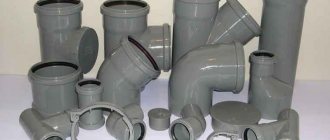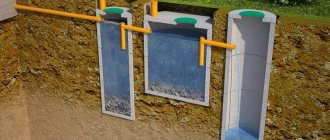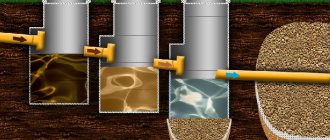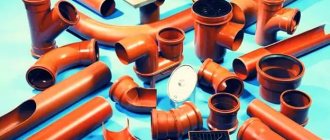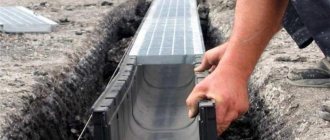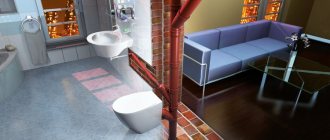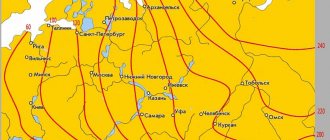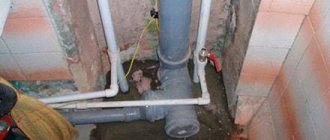Any sewerage network is formed by its components, or sewerage elements. These are all the components from which the pipeline complex is assembled, including additional components and structures. Depending on the type of system, the specifics of its operation and the composition of the components differ.
When drawing up a drainage project, it is necessary to take into account the objectives of the network and select suitable elements. To do this, first of all, you need to know exactly the design features and composition of a particular line. Let's look at the main types of networks and the elements they consist of.
Design features of drainage systems
The sewerage elements together solve a specific problem. Depending on the type of network, they have different sizes, devices and parameters. However, different types of wastewater systems have a common structure. It allows excess waste liquids to be directed to disposal sites. Any network is a set of pipelines (less often, open trays) through which liquid moves to treatment facilities.
The sewerage system includes:
- pipes;
- fitting;
- wells;
- siphons;
- pumps;
- fan pipes;
- check valves;
- trays (gutters);
- receiving funnels;
- sand traps;
- containers for temporary storage of wastewater, etc.
The details listed apply to different types of networks. As a rule, all of them together are not found in any system, since they have their own specifics and are designed to perform individual functions.
The main elements of sewerage are pipes and fittings. Any system primarily consists of them, and the remaining components and parts are needed for maintenance or repair. As a rule, drainage networks are gravity-fed. However, terrain, soil conditions or the presence of previously constructed facilities sometimes prevent the construction of gravity lines. In such cases, pumping stations (pumping stations) are used, which transfer wastewater to a higher elevation, from where the liquid moves in the usual manner.
In addition, there are storm drainage systems. They often consist of open trays, making cleaning and maintenance easy. Stormwater networks operate only in the warm season, so deep pipe laying, insulation and other measures are not needed. If water remains in the system, it will freeze in winter and burst the pipes. This is another argument in favor of open trays.
Topology of sewer systems
Almost any modern sewer system consists of those sections that are located above the surface of the earth, and those that are laid directly into the ground or into cavities specially prepared for this purpose in it. In addition, it includes underground sewage tanks, which are intended to accumulate wastewater and purify it from impurities in accordance with accepted sanitary and hygienic standards.
As a rule, above-ground sewerage represents that part of the overall system that is located in buildings and structures, as well as in close proximity to the surface of the earth (for example, most of the stormwater communications). Underground sewerage is characterized by the fact that it is buried in the soil, and therefore all its elements are hidden from view. These include pipelines and specialized tanks.
Underground sewerage
Design and installation of underground sewerage, as a rule, is a more technically complex, time-consuming and expensive procedure. It requires mandatory consideration of factors such as the expected volume of wastewater discharge per unit of time, geography of the area, as well as climatic conditions. According to current rules and regulations, underground sewerage installation must be carried out below the freezing depth of the soil in winter. Almost all modern equipment used for wastewater treatment and included in sewer systems is designed specifically for underground installation.
Aboveground sewerage
This part of the sewer system requires careful calculation and design, since it is intended to collect all wastewater that must be treated and further discharged into the environment. Aboveground sewerage installation is a rather difficult task, the solution of which should only be carried out by true professionals in their field. For the manufacture of its components, materials such as plastic and fiberglass are now often used, which are characterized by strength, resistance to various types of mechanical and chemical influences, and also a relatively low price.
Basically, PVC products are used for the construction of modern sewers, which have many advantages and disadvantages. But pipes of other materials, which have their own characteristics, can be used. Due to the fact that the consumer is primarily interested in which pipe to use for underground sewerage in accordance with his budget, we will consider suitable and affordable varieties.
Materials
Sewage elements are made from different materials:
- cast iron;
- reinforced concrete;
- asbestos cement;
- ceramics;
- plastic.
Cast iron parts are strong and durable. Until recently they were used in all systems, internal or external. Their only drawback is their heavy weight, which makes installation difficult. In addition, joining cast iron pipes or fittings requires the use of special techniques.
Reinforced concrete pipes are still used to assemble collectors or main lines. They are distinguished by their large diameter and weight, so such elements are not used for private systems.
Asbestos-cement elements of the sewer network show good performance, but due to the presence of asbestos in the composition, their production has recently been discontinued. Ceramic pipes are also rare due to high prices. Firing the material requires a lot of energy consumption, so the final cost of the products becomes too high.
The difficulty of assembly is a drawback of all pipes, with the exception of plastic ones. They appeared relatively recently, but almost immediately took a leading position. Today, almost all the main elements of the internal sewage system are made of polymers. The external areas still retain the old design, but modern and convenient products are used everywhere to replace them. The advantages of plastic parts turned out to be very great:
- light weight;
- ease of assembly;
- resistance to water and chemical elements;
- ability to withstand temperature changes;
- durability.
In addition, there are several types of plastic pipes and fittings on sale:
- PVC;
- polyethylene;
- propylene.
PVC sewer system elements are considered the most popular, but other types are not inferior to them. The reason for the high demand for vinyl components is the low price, otherwise all types show excellent qualities.
Composition of the external sections of the system
External sewerage is an area located outside the walls of buildings or structures. As a rule, this is an extensive network of underground pipelines laid downhill at a given depth. The external sections of the system include:
- pipes;
- fittings (elements that provide a change in direction or branching of the network);
- wells.
Pipes and fittings for external lines last a long time, which is why concrete and cast iron networks are still in use. Wells are used to solve various problems:
- viewing, auditing. Needed for cleaning or repairing the system;
- differential. Provide a connection between two lines laid at different levels;
- rotary. Used to change the direction of flow;
- extinguishing. They serve to dampen the energy of the flow leaving the pressure sewer section.
Most networks are gravity-fed. This is the simplest design option for a drainage system. However, there are often cases when laying a line using the usual method is impossible. If there are obstacles to assembling the gravity line, use a pressure sewer section. It consists of two tanks located at different heights, connected by a pressure pipeline. A mud pump is installed in the lower tank, which pumps wastewater into a slurry well, from where the liquid can move independently.
Also read: Is it possible to clean the sewer with electrolyte: how to use it, can it be rinsed?
Installation of external sewage system at the dacha
The installation of external sewerage includes the laying of underground pipelines from buildings to the wastewater receiver, the installation of a biological treatment station and the removal of purified water from the station to the discharge point.
Laying sewer pipes at the dacha
is carried out at a relatively shallow depth - from 0.6 to 1 meter at the place where it is connected to the treatment plant.
With a slope of 1.5 - 2 cm per meter, it is not difficult to calculate the depth of its placement at the point of connection to the riser of the internal sewerage system. The laying of external sewerage
is carried out on a previously prepared surface of the base of the trench.
Leveling the bottom of the trench is done using sand, which, after backfilling and spreading along the bottom of the trench, is necessarily spilled with water. The bottom of the trench is thrombosed and only after this they begin to lay sewer pipelines. For underground installation, thick-walled sewer pipes should be used. Only they are able to withstand the pressure of the soil above them. When constructing underground sewers, we use only thick-walled pipes made of soft polypropylene. The underground sewage system of a dacha
, mounted from such pipes, is characterized by high strength, and as a result, a long service life of underground sewer pipelines.
Today, more and more country sewage systems are equipped with biological wastewater treatment stations. We install some of the best treatment plants of the Topas brand. The sewage that enters the station is ultimately purified by almost 90%; the water flowing out of the station can be used for watering plants or for other technical needs.
Installing biological treatment stations is the only correct solution for constructing a sewerage system in clay soil. Clay and loam are absolutely waterproof soils, so using various types of septic tanks as wastewater receivers in such soils is absolutely the wrong decision. In clayey types of soil, purified water is discharged only to the surface - into a road ditch, ravine, or simply to the surface. Due to severe environmental pollution, drainage of sewage from septic tanks and other settling tanks to the surface is not possible! Installation of various types of septic tanks, including those built from reinforced concrete rings, is possible only in sandy soils and at a respectful distance from water sources. Water drainage in sandy types of soil can be carried out not only to the surface, but also directly into a drainage well. From it, the water gradually goes into the deep layers of the soil, gradually being purified in a natural biological way.
“Topas” treatment stations are a whole range of models, including stations of various capacities, from the most low-power ones designed for no more than 5 people to installations capable of purifying sewage from an entire village. In most cases, installation of country sewerage is carried out using biological treatment stations “Topas 5”, “Topas 8”, “Topas 10” and “Topas 15”. Of these most common models, purified water can be discharged not only by gravity, but also by force. Using a special drainage float pump made in Spain. In most cases, we install stations with forced release of purified water. Stations with gravity discharge of purified water can only be installed next to a ravine or a deep drainage channel, which, as you understand, is very rare.
Composition of internal sewerage
Elements of the internal sewage system are located inside buildings or structures. They form the initial section that collects wastewater from plumbing fixtures, washing machines or dishwashers. The outer boundary is considered to be the first well, located 5 m from the foundation.
Main elements of internal sewerage:
- horizontal lines with a diameter of 50 mm (apartment lounger);
- vertical pipeline with a diameter of 110 mm (riser);
- horizontal part providing exit from the house (110 mm basement lounger).
To change the direction, cleaning, ventilation, fittings are used:
- audit;
- tap;
- tee;
- air valve;
- corrugation for the toilet;
- outlet sets for plumbing;
- siphons providing a water seal.
An important area is the fan pipe. This is the upper part of the riser, which allows the pipeline cavity to exit to the atmosphere for ventilation. All elements of the internal sewage system are equipped with universal connecting pipes. Therefore, installation occurs quickly and without difficulty.
Current requirements
Layout of the septic tank on the site
When designing and installing a collector, it is important to adhere to sanitary standards and regulations (SNiP). Otherwise, the efficiency of the system will be zero.
Requirements for the location and installation of external sewerage:
- The cesspool or septic tank is located at least 5 meters from the house. From wells or wells - at a distance of 20 meters.
- The pipeline material must be durable and corrosion-resistant.
- The depth of installation of the collector is located below the freezing point of the soil in the area. Otherwise, the pipeline is properly insulated.
- Turns and bends should not be mounted at 90 degree angles. Sharp changes will lead to blockages in the collector.
- Slope. One of the most important points when installing a sewer system. In order for sewage to flow into the receiver by gravity, you need to lay the pipes at a slope towards the septic tank/pit. The smaller the tube lumen, the greater the slope. With a cross section of 50 mm, the slope of the gravity sewer is 3 cm per 1 linear meter of the collector. With a diameter of 100 mm - 2 cm/m.p. With a cross section of 160 mm or more, 0.8-0.7 mm/m.p.
According to SNiP, a foundation must be provided for sewer pipes and a septic tank. The heavier the commutator, the more durable it should be. A concrete pad is poured under the polymer barrels and aeration tanks; a sand cushion is sufficient for the pipes.
Storm network
The storm drainage system consists mainly of open trays. In addition to them, the composition includes:
- building drainage complex;
- receiving funnels;
- sand traps and filters;
- wells.
Underground sections of the network are used less frequently, only for certain sections or for passing the line under structures, embankments or other obstacles. Sometimes stormwater networks are connected to utility networks if the composition of the wastewater allows this.
Aboveground and underground sewerage from Flotenk
One of the main specializations is the development of complexes of sewer systems, consisting, as a rule, of above-ground and underground parts. By contacting this company, you can either buy ready-made standard systems that have proven themselves in practice, or order specialized ones that best meet the specifics and needs of each specific client. manufactures almost all elements of these engineering complexes on its own production base from such modern material as fiberglass.
